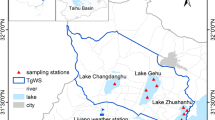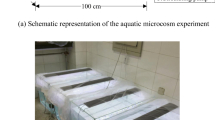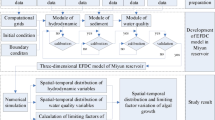Abstract
The growth of algae in eutrophic lakes is greatly influenced by the various factors such as nutrients, water temperature, and solar radiation intensity. In order to manage and maintain the ecosystem in the lakes, it is necessary to understand the dynamics of the nutrients as well as the factors affecting the algae growth seasonally. In this study, an ecosystem model based on the genetic algorithm (GA) for the optimization of the parameters during the model validation was developed to simulate the growth of algae groups (green algae, blue-green algae, and diatom algae) and analyze the principal factors affecting their growth in a eutrophic shallow lake in the inner Hanoi City. The survey of each algal group and other related variables of water quality were conducted from May 2017 to March 2018 to calibrate and verify the developed model. The principal factors affecting the algae growth were evaluated through the functions that limit their growth. Seasonal variation in the production components (including diffusion from sediment, atmosphere, and algae excretion) and consumption (photosynthesis) of dissolved inorganic phosphorus (DIP) are also quantified. Moreover, the model developed in this study promises to be a useful tool to simulate the relationship between algae biomass and nutrient concentration, as well as forecasting changes in composition and density of algae in the eutrophic lakes.













Similar content being viewed by others
References
APHA. (2001). Standard methods for the examination of water and waste water (21st ed.) Washington.
Cerco, C.F., & Cole, T.M. (1994). CE-QUAL-ICM: a three-dimensional eutrophication model, version 1.0.: User’s guide, US Army Corps of Engineers Waterways Experiments Station, Vicksburgh, MS.
Dowd, M. (2005). A bio-physical coastal ecosystem model for assessing environmental effects of marine bivalve aquaculture. Ecological Modelling, 183, 323–346.
Duong, T. T., Ho, T. C., Dang, D. K., & Le, T. P. Q. (2012). Variation in microcytin concentrations in water environment of the Hoan Kiem lake. Journal of Biology, 34(1), 94–98.
Harada, M., Douma, A., Hiramatsu, K., Nguyen, D. T., & Marui, A. (2013). Analysis of seasonal changes in water qualities in eutrophic reservoirs in a flat low-lying agricultural area using an algae-based ecosystem model. Irrigation and Drainage, 63, 24–35.
Iseri, H., Harada, M., Hiramatsu, K., Mori, M., & Marui, A. (2008). Evaluation of water quality environment in eutrophic reservoirs using an ecosystem model. Science Bulletin of the Faculty of Agriculture, Kyushu University (in Japanese with English summary), 63, 147–160.
ISO 5667-4:2016. (2016). Water quality-sampling-part 4: guidance on sampling from lakes, natural and man-made. International Organization for Standardization.
James, R. T. (2012). The Lake Okeechobee Water Quality Model (LOWQM): calibration/validation update 2012. South Florida Water Management District, 40.
James, R. T. (2016). Recalibration of the Lake Okeechobee Water Quality Model (LOWQM) to extreme hydro-meteorological events. Ecological Modelling, 325, 71–83.
Lap, B. Q., Mori, K., & Hirai, Y. (2006). Some primary characteristics of water quality in a closed water body in Sasaguri, Fukuoka prefecture, Japan. Journal of the Faculty of Agriculture, Kyushu University, 51(2), 315–321.
Lap, B. Q., Harada, M., & Hiramatsu, K. (2014). The initial result of development of k–ε model for simulation of hydrodynamics in lakes toward to simulation of their water quality. Journal of the Faculty of Agriculture, Kyushu University, 59(1), 155–161.
Nguyen, D. T., Harada, M., & Hiramatsu, K. (2010). Evaluation of the water-quality dynamics in a eutrophic agricultural pond by using a one-box ecosystem model considering several algal groups. Paddy and Water Environment, 8(4), 301–318.
Nguyen, D. T., Harada, M., Hiramatsu, K., & Fukuda, S. (2014). Application of a simple genetic algorithm for the calibration of aquatic ecosystem model ofan agricultural pond. Paddy and Water Environment, 12, 1–15.
Nguyen, T. B. N., Nguyen, B. T., Vu, D. A., Le, T. P. Q., Le, D. N., Duong, T. T., & Ho, T. C. (2017). Assessment of the trophic status in some lakes within Hanoi inner city. Vietnam J. Sci. Techno., 55(1), 84–92.
Odum, E., Barrett, G.W. (2004). Fundamentals of ecology., 5th ed. Cengage Learning.
Odum, H. T., & Odum, E. C. (2000). Modeling for all scales: an introduction to system simulation. London: Academic Press.
Srinivas, M., & Patnaik, L. M. (1994). Adaptive probabilities of crossover and mutation in genetic algorithms. IEEE Transactions on Systems, Man, and Cybernetics, 24(4), 656–667.
Steele, J. H. (1965). Notes on some theoretical problems in production ecology. In C. R. Goldman (Ed.), Primary production in aquatic environments. Berkeley, California: University of California Press.
Strathmann, R. R. (1967). Estimating the organic carbon content of phytoplankton from cell volume or plasma volume. Limnology and Oceanography, 12, 411–418.
Thuan, T. D., & Lap, B. Q. (2018). Some characteristics of eutrophication in a shallow lake in Hanoi. J. Water Res. Environ. Engine., 61, 52–61.
Whitley, D. (1994). A genetic algorithm tutorial. Statatics and Computing., 4, 65–85.
Yang, L., Zhao, X., Peng, S., & Li, X. (2016a). Water quality assessment analysis by using combination of Bayesian and genetic algorithm approach in an urban lake, China. Ecological Modelling, 339, 77–88.
Yang, L. K., Sen, P., Xin-hua, Z., & Xia, L. (2016b). Development of a two-dimensional eutrophication model in an urban lake (China) and the application of uncertainty analysis. Ecological Modelling, 345(63–74), 2017.
Author information
Authors and Affiliations
Corresponding author
Additional information
Publisher’s Note
Springer Nature remains neutral with regard to jurisdictional claims in published maps and institutional affiliations.
Rights and permissions
About this article
Cite this article
Lap, B.Q., Ta, D.T. Analysis of the Principal Factors Affecting the Algae Growth in an Urban Eutrophic Shallow Lake by an Ecosystem Model. Water Air Soil Pollut 231, 537 (2020). https://doi.org/10.1007/s11270-020-04895-2
Received:
Accepted:
Published:
DOI: https://doi.org/10.1007/s11270-020-04895-2




